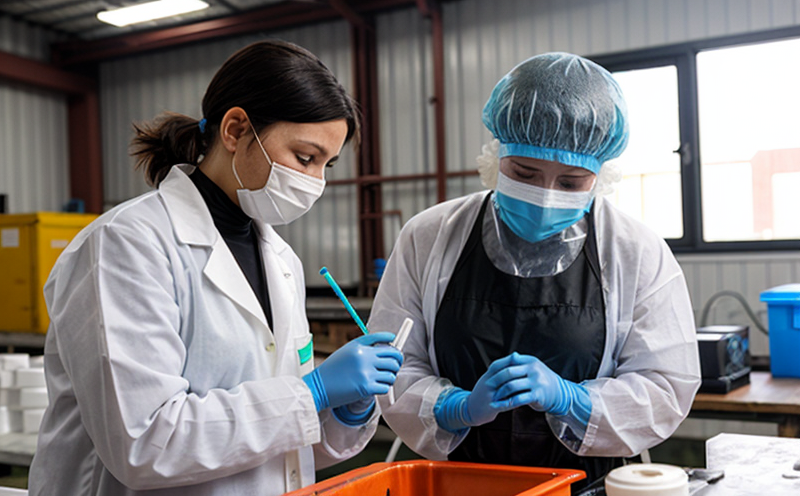JIS K7129 Oxygen Transmission Rate of Recycled Packaging Films with Nano Additives
The JIS K7129 standard is a crucial guideline for quality managers, compliance officers, and R&D engineers looking to ensure the integrity and performance of recycled packaging films enhanced with nano additives. This test measures the oxygen permeability or transmission rate (OTR) of these materials, which is essential for maintaining product freshness and shelf life during storage and transport.
Recycled packaging films are increasingly being used in consumer products to reduce waste and meet sustainability goals. However, incorporating nanomaterials into these films can significantly affect their performance characteristics, such as barrier properties against gases like oxygen. Accurate measurement of OTR helps manufacturers understand how well the film protects the contents from oxidation or other forms of degradation.
OTR testing according to JIS K7129 provides a quantitative measure that allows for consistent quality control across production batches and suppliers. It enables companies to optimize their packaging design, ensuring it meets both environmental and functional requirements. Understanding OTR is particularly important when dealing with recycled materials due to potential variability in composition and structure compared to virgin films.
The test involves placing the specimen between two chambers maintained at different oxygen pressures. Over time, oxygen diffuses through the film from one chamber to another until equilibrium is reached. The rate of this diffusion is then measured using sensitive detection equipment calibrated according to JIS K7129 specifications.
| Step | Action |
|---|---|
| 1 | Select appropriate specimen dimensions based on JIS K7129 requirements. |
| 2 | Precondition the sample in a controlled environment to ensure homogeneity. |
| 3 | Place the specimen between two chambers with known oxygen pressures. |
| 4 | Allow gas exchange until equilibrium is achieved, typically over several hours. |
| 5 | Detect and record the amount of oxygen that has passed through the film. |
| 6 | Analyze data according to JIS K7129 standards for accuracy and precision. |
Why It Matters
Accurate measurement of OTR is vital in the recycling industry, especially when incorporating nanomaterials. These additives can enhance barrier properties but may also introduce variability into material performance. Understanding how effectively recycled films protect products from oxygen exposure helps manufacturers make informed decisions about their packaging design and supply chain management.
For quality managers responsible for ensuring product integrity, OTR testing ensures that each batch meets the necessary standards set by JIS K7129. Compliance officers rely on such tests to confirm adherence to regulatory requirements related to food safety and environmental protection. R&D engineers use these results to refine their formulations, balancing performance with sustainability.
- Ensures consistent product quality across different batches and suppliers
- Helps optimize packaging design for maximum efficiency
- Safeguards against potential legal issues arising from non-compliance
- Supports sustainable practices by minimizing waste while maintaining product integrity
Scope and Methodology
| Parameter | Description |
|---|---|
| Dimensions | At least 10 cm x 10 cm, with a thickness ranging from 5 to 25 micrometers. |
| Conditioning | The specimen must be conditioned in an environment meeting JIS K7129 conditions for at least 24 hours before testing. |
| Purity | All contaminants should be removed from the surface of the specimen to prevent interference with measurement accuracy. |
| Type | Description |
|---|---|
| Oxygen Transmission Rate Tester | A device capable of maintaining precise pressure differentials across the film sample and accurately measuring oxygen transmission. |
| Environmental Control Unit | An apparatus to control temperature, humidity, and other environmental factors affecting the test. |
Why Choose This Test
- Precision: Utilizes advanced equipment calibrated specifically for JIS K7129 compliance.
- Consistency: Ensures that all samples are tested under identical conditions, leading to reliable comparisons between batches or suppliers.
- Compliance: Meets international standards, providing a robust foundation for regulatory and certification purposes.
- Efficiency: Minimizes testing time through optimized procedures while maintaining high levels of accuracy.
- Accurate measurement ensures that recycled packaging films meet the stringent requirements set by JIS K7129, enhancing product safety and quality.
- The test provides valuable insights into how nanomaterials impact the barrier properties of recycled films, guiding improvements in formulation and design.





